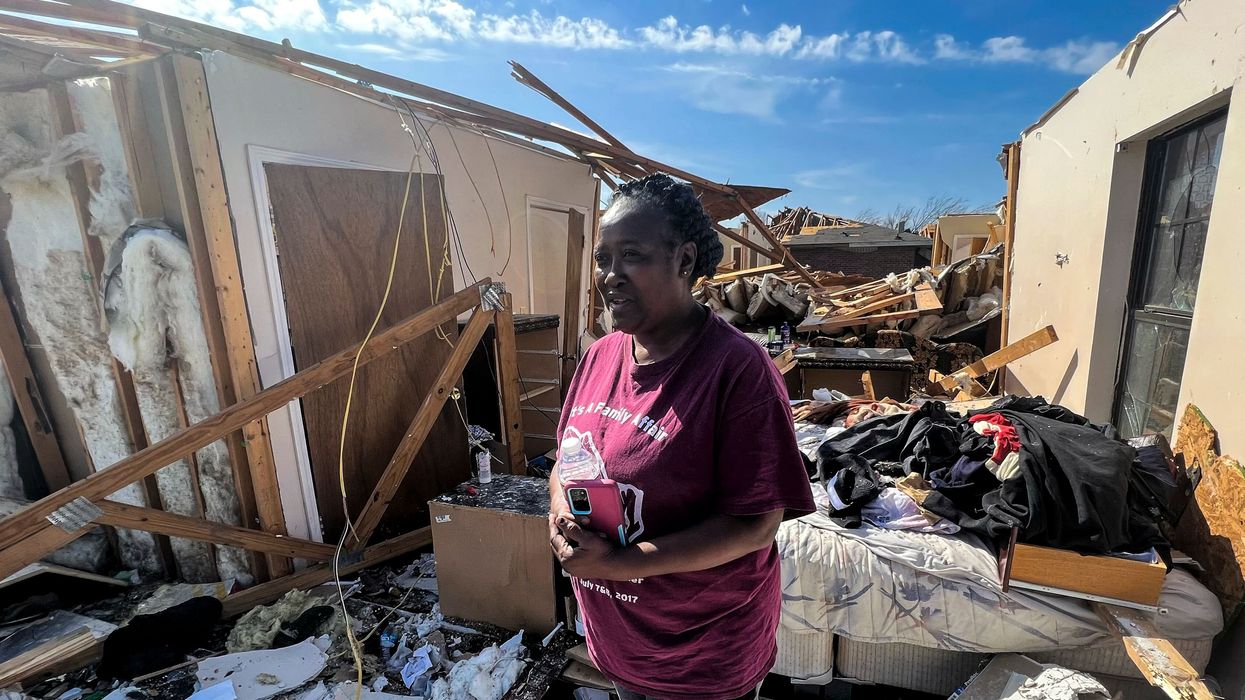(CNN) — People of color in the US face heightened risks of harm from climate-induced disasters. Now, non-profits are pushing to remedy that disparity with more equitable approaches to disaster preparedness, response and recovery.
"Until we really address the root issues of climate injustice, we're going to continue to see a disproportionate impact as it relates to disasters in Black and historically excluded communities," said Abre' Conner, Director of Environmental and Climate Justice for the NAACP.
The unequal toll of climate disasters
A report by the EPA's Office of Atmospheric Programs looked at four vulnerable social groups: people living on low-income, racial minorities, those with no high school diploma, and seniors over age 65. Of those four groups, the study found minorities are most likely to live in areas projected to be impacted by climate change.
Moreover, Black people are 40 percent more likely than non-African-Americans to live in areas with the highest projected increases in mortality rates due to changes in extreme temperatures.
It's a dire warning for the future, based on an inequitable past.
Many marginalized people, Black in particular, have faced socioeconomic factors that relegate them to living in environmentally hazardous areas or substandard housing structures. So, when a natural disaster hits, they are ill-equipped to withstand the impact.
That was the situation this past March 24 when a severe tornado leveled much of the Black-majority rural town of Rolling Fork, Mississippi, killing 26 people. Racial disparities existed in Rolling Fork for decades. Many residents there were poor, had low access to information or internet service, were priced out of insurance coverage, and lived in mobile homes that weren't retrofitted to withstand severe weather conditions. With the nearest tornado shelter over 15 miles away, it set the perfect storm to leave people displaced and scrambling for aid and assistance, which was very slow to arrive.
"The tendency is to ignore and exclude, and that's a violation of human rights," said Chauncia Willis, CEO and founder of the Institute for Diversity and Inclusion in Emergency Management (I-DIEM).
Willis' group deploys equity response teams before and after disasters to help community organizations integrate equity into all facets of disaster policy and practices. She started I-DIEM after spending over 14 years in disaster management.
"I've witnessed the disparities, and it hits a little different when the people look like you," Willis said in an interview with CNN.
Almost three weeks after the tornado, Rolling Fork's mayor said about 500 people — roughly a third of the town's population — remained displaced, leaving victims with questions and concerns. To provide some answers, FEMA, MEMA (Mississippi Emergency Management Agency), the Small Business Administration, and the American Red Cross are holding a series of town halls, the first of which took place Tuesday at South Delta Elementary School.
Housing is a major concern at the present. "It wasn't just Rolling Fork; it was all of those other communities surrounding that were also impacted by the tornado," said Willis. "That's going to be the difference between life and death in the future."
The future is concerning; marginalized communities historically endured long-term effects from disasters.
Remnants of destruction are still visible In New Orleans' primarily Black 9th ward 18 years after Hurricane Katrina.
Lingering effects of racism
Although natural disasters don't discriminate, the response can, especially when the lingering effects of structural racism hamper relief.
In Katrina's aftermath, Louisiana instituted a "Road Home" program, disbursing emergency funds based on appraised home values rather than actual rebuilding costs. But after decades of discriminatory economic practices including redlining, homes in historically White communities typically appraised far higher than comparable houses in Black neighborhoods.
Also, New Orleans' White neighborhoods tend to sit on higher ground with less risk of flooding and easier access to jobs and resources. The circumstances after Katrina ended up forcing many Black families out of the city.
"Poverty should not hinder survival from disasters. Being a person that is not White shouldn't limit your survival," said Willis.
But there is growing awareness of the unfairness and concerted efforts to fix it. Sally Ray from the Center for Disaster Philanthropy says racial and socioeconomic disparities are key factors guiding where her organization deploys funding.
"I think we need to quit being uncomfortable talking about the intersection of climate change, racism, and disasters," Ray told CNN. "The reality is we have long systemic racist problems across our country, and because of these things, when a disaster comes, it's much more devastating."
The problem with emergency management response
A growing body of research spotlights the historical inequity in federal disaster response.
One 2018 study by sociologists from Rice University and the University of Pittsburgh looked at counties that each suffered the same amount ($10 billion) in hazard damage. In those events, Black survivors' wealth decreased by an average $27,000 while White survivors' average wealth increased $126,000.
In 2020, FEMA's advisory council acknowledged the inequities and called for the agency to address the issue.
On January 20, 2021, President Biden signed Executive Order 13985 to advance racial equity and support for underserved communities through the federal government. Since then, FEMA has undertaken initiatives to expand access and reduce barriers to their response, recovery, and resilience programs.
In an email to CNN, FEMA spokesman Jeremy Edwards said, "Recognizing this and the realities of historically underserved communities, FEMA — under the leadership of Administrator Criswell — has undertaken a number of initiatives to reduce barriers, so all people, including those from vulnerable and underserved communities, are better able to access our assistance."
The agency has simplified the eligibility process, expanded the ways survivors can verify home occupancy, and prioritized casework for vulnerable populations.
FEMA says these changes have enabled 124,000 survivors to access over $709 million in assistance they would have previously been ineligible to receive.
But non-profit leaders want FEMA to do more.
"I think that in earnest they are trying to correct, but we can still do better in pushing to ensure these recoveries are equitable," said Art delaCruz, CEO of Team Rubicon. This veteran-led humanitarian organization assists global communities before, during, and after disasters and crises.
Grassroots activists insist equitable disaster planning and response must start with local voices.
"The future of disaster management is actually going to be at the local level with the locals as the lead rather than the federal government or state government," explained I-DEIM's Willis.
Inherent distrust of authorities after years of racist and discriminatory practices is one reason why. Another reason is simple pragmatism.
"Who knows the community better?" asked Willis, whose group helps set up Community Resilience Hubs and local-led facilities to support neighbors, coordinate communication and provide emergency management training.
Willis emphasizes that these types of initiatives, and more, need to be done before disasters strike. "When people are not prioritized before a disaster, those same people will bear the brunt."
Non-profit and community-based organizations leading equity by filling in gaps
For a long time, non-profit organizations have been counted on to plug gaps that the government had yet to fill in disenfranchised communities. And increasingly, non-profits are doing things differently to address racial disparities in disaster management.
For Team Rubicon, that means using tools like the CDC/ATSDR Social Vulnerability Index. The index, launched by the Center for Disease Control and the Agency for Toxic Substances and Disease Registry, uses 16 variables to help emergency planners and officials identify vulnerable communities before, during, or after disasters. Those variables include social factors like poverty, lack of transportation, and crowded housing. The databases and maps generated by the tool help estimate supplies required, emergency personnel needs, evacuation procedures, and even whether an area needs emergency shelters.
"As we see a disaster strike an area, that is where we try to deploy because we know that's where the greatest need is," explained delaCruz.
The Center for Disaster Philanthropy focuses on identifying a diverse pool of applicants in their grantmaking, pushing more funds to organizations supporting struggling communities of color, and listening to the needs of the affected people on an individualized basis.
"We work really at the local grassroots level to get to know the community," said the Center for Disaster Philanthropy's Sally Ray, who spoke to CNN from Oklahoma City, which was hard-hit by tornadoes last year. She and her team are on the ground, accessing lingering issues and working on proactive ways to support the town throughout this year's tornado season.
"Our goal has always been to leave a community in a better place and be there for the long-term commitment to that, Ray added.
Meanwhile, many non-profits, especially at the local level, are overstretched as major disasters become more frequent and destructive.
"There are communities that have suffered disaster after disaster after disaster, and the toll on the people and the community increases each time that happens," said delaCruz.
"We need to start integrating community-based organizations into the global emergency management structure," said Willis.
Building resilience
Disasters destabilize communities as well as economies. That is why much of the conversation among emergency management leaders lately has focused on building an inclusive approach to disaster resilience.
"In Rolling Rock, there's been a disaster. Now is the time to rebuild with the proper strategy, with forethought, a focus on resilience, and a focus on life-saving equity," Willis from I-DIEM explained. She said these resilience efforts must include disaster preparedness and infrastructure improvement and awareness of socioeconomic issues impacting marginalized communities.
FEMA says they are committed to helping Mississippi recover.
To date the agency says they have visited 1,400 homes in Sharkey County alone, interacting with over 2,400 survivors and registering hundreds for assistance. They've also provided more than $5.4 million to Mississippi households since the deadly tornadoes struck earlier this year.
The agency also implemented some grassroots efforts like non-financial direct technical assistance to help build community-wide resilience in 20 communities, tribes, and territories.
Nonprofits continue to play a crucial role. But the problem looms large, and when it comes to disaster response for historically marginalized communities, there's more than enough workload to go around.
"There is no value in not directly preparing communities of color," Willis said. "The government already underserves them. Do they also need to be underserved by humanity?"
The-CNN-Wire
™ & © 2023 Cable News Network, Inc., a Warner Bros. Discovery Company. All rights reserved.

















































